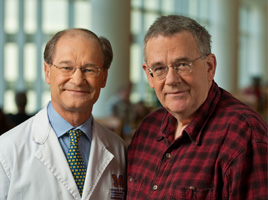
Kim Eagle, M.D., and Walter B. Hewlett
In 2005, Walter B. Hewlett began a new venture when he decided to transplant heritage Italian olive tree rootstock from Tuscany to his family’s ranch in California’s Central Valley. His passion for the fine culinary experience of hand-crafted olive oils with their natural health benefits, and his determination to produce them in an environmentally and agriculturally responsible manner is evident in every bottle of Owens Creek Company Olive Oil.
In December 2009, Walter reached out to the University of Michigan Cardiovascular Center to see if there was a way to promote his olive oil while benefitting research efforts there. His family already supported an endowed professorship named in his grandfather Albion Walter Hewlett’s honor. In the spirit of his grandfather’s legacy, it made perfect sense that Walter’s artisan olive oil would benefit the institution that holds the contributions of Dr. Hewlett to the early development of the Medical School in the highest esteem.
Chief of Medicine
Albion Walter Hewlett was a founding father of cardiology who served as the Michigan Medical School’s Chief of Medicine from 1908-1916 (his last post before becoming Chair of Medicine at the newly formed Leland Stanford School of Medicine). The main focus of Dr. Hewlett’s research throughout his medical career was the cardiovascular system. At the time of his arrival at Michigan, Dr. Hewlett was considered the best young clinician in the country. He was a strong proponent of making medical practice more scientific, believing that a good medical school could only be great with a strong integrated research program.
The Zingerman’s Connection
Zingerman’s has a long-standing history of commitment to the community of Ann Arbor and has been recognized as “the country’s leading olive oil purveyor.”* Their winning combination of compassion and expertise makes them a natural partner with Owens Creek Company and the U-M Cardiovascular Center, forming the perfect trio to promote heart health in the community while supporting preventive cardiovascular research.
*Resource: Corby Kummer, The Atlantic Monthly
He is credited with bringing the first electrocardiogram machine to Michigan’s campus in 1913. Dr. Hewlett was a founding member of the American Society for the Advancement of Clinical Investigation, a co-editor of the medical journal Heart, and a chairman of the American Medical Association during his tenure at the University.
Beginning in 1912, Dr. Hewlett created an elective course in circulation that included disturbances of cardiac rhythm, the consequences of valvular lesions, the causes and effects of hypertension and pulmonary edema. He also published papers on cardiac arrhythmias and disorders of cardiac conduction, among other related topics. Much of the work that is done in the clinics and research labs of Michigan’s Cardiovascular Center today are in direct correlation to the early efforts of Dr. Hewlett and his colleagues.
Resource: Medical Lives and Scientific Medicine at Michigan, 1891-1969, Joel D. Howell, Editor (published University of Michigan Press/Regional; 2nd printing edition, February 1, 1994)


